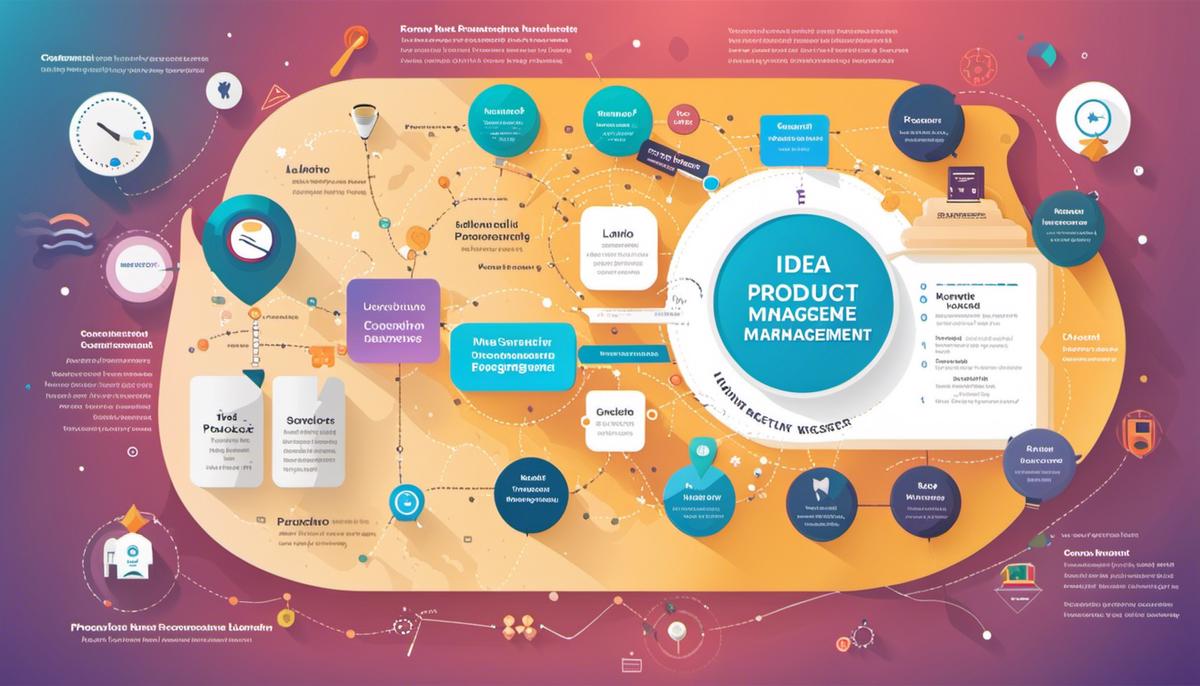In an ever-evolving business landscape, the role of a product manager is extremely requisite, acting as a significant cog in the corporate machine. The discipline of product management is dynamic and multifaceted, encompassing everything from strategic thinking to meticulous execution. While it often proves challenging, it can also be incredibly rewarding for those who master the manifold aspects of the role. This guide aimed to provide a comprehensive understanding of product management, shedding light on the integral role of a product manager, key skills necessary for success, the elementary processes involved, pertinent tools and technologies, and the potential challenges encountered along the way.
Understanding Product Management
Understanding Product Management
Product management is a key role within any organization that deals with the planning, production, and marketing of products. It involves the tandem work of various teams and departments, aligning them towards a unified goal–the successful launch of a new product. It’s a role that requires strong leadership and communication skills, as well as a deep understanding of both the market and the product.
Product Managers, often referred to as PMs, are central to the success of product management. They serve as the primary point of contact for all product-related activities. Their responsibilities include setting the product vision, overseeing development, and ensuring that the product meets the needs of the customers and achieves the desired business objectives. More importantly, a PM is responsible for optimizing the product value throughout its life cycle, from planning to retirement.
The Importance of Product Management
Product management is a cornerstone in a business’s ability to succeed in the modern market. It provides direction and focus, ensuring that everyone in the organization is working towards the same end goal. It bridges the gap between different departments–from engineering and design to marketing and sales–enabling them to work seamlessly and efficiently.
An effective product management system reduces costs and boosts revenues by ensuring that products meet market needs. It also enables businesses to anticipate shifts in market trends, adapt accordingly, and maintain a competitive edge.
Furthermore, product management helps businesses manage their resources effectively. It prioritizes the features and changes required, thus reducing wasted effort and focusing on what is most likely to increase the product’s success.
Product Management: Distinctly Different from Project Management
Although they seem synonymous to some, there’s a unique difference between product management and project management in the business milieu.
Product management focuses on directing a product’s success and orchestrating the cross-functional teams tasked with its optimization. As a strategic role, it stretches beyond a single project’s lifespan and covers the entire product lifecycle. It’s about outlining the product vision, setting the execution roadmap, and making strategic decisions.
Contrarily, project management involves the efficient allocation and arrangement of resources to ensure the successful completion of a project within defined scope, time, and cost constraints. The primary challenge is to fulfill all the project’s objectives while managing common constraints, which normally include the parameters of scope, time, quality, and budget.
In essence, if product management is the compass guiding the ship’s direction, then project management is the engine empowering the ship to move efficiently. Understanding the distinct roles of both will reinforce the creation and development of a successful product.

Key Skills for Effective Product Management
Drawing the Blueprint for Success: Key Skills for Product Management
To understand what makes a product manager successful, it’s crucial to identify the essential skills this role requires. Ranging from strategic thinking to decision-making, stellar communication abilities, and leadership qualities, not to forget the increasingly crucial skill – data analysis.
Strategic Thinking
Strategic thinking is paramount for a product manager. It’s their responsibility to understand the market, dissect competitive trends, and craft the product’s future direction in a way that fulfills customer needs and stimulates revenue growth. Take Spotify’s early years as an example: product managers recognized that simply offering online music streaming wasn’t enough – it became about personalization, providing a solution that resonated deeply with music lovers. This strategic move fueled Spotify’s unprecedented growth.
Decision-Making
Decision-making is yet another critical skill for product managers. The ongoing success of a product relies heavily on the product manager’s ability to make difficult decisions, often in scenarios where the data is insufficient or stakeholders have conflicting priorities. At a pharmaceutical company, for example, a product manager might be tasked with deciding whether to invest in research and development for a potential new drug or to spend those resources marketing existing drugs.
Effective Communication
Effective communication is key in product management. A product manager acts as a link between various cross-functional teams, stakeholders, and customers. They need to communicate the product vision, customer requirements, and feedback to the respective parties concisely and clearly to ensure effective collaboration. An example includes Adobe product managers who are required to consistently communicate with engineering teams, designers, and marketers to ensure the successful launch of products like Adobe Creative Cloud.
Leadership Skills
Leadership skills are essential for driving the team towards the common goal of creating a successful product. A good product manager, like the one at Tesla, leads not just through hierarchy but by influence. They help team members understand the vision of the product, instill a sense of ownership and guide them to realize that vision.
Data Analysis: A Key Skill for Product Management
Data analysis has emerged as an indispensable skill for product managers in the digital age. While you don’t have to be a data scientist, an aptitude for interpreting data is unquestionably beneficial. It’s crucial to comprehend various data types, whether they revolve around customer usage, market research, or financial metrics. A prime example of this can be seen in Airbnb’s product management. Their team heavily relies on data to comprehend customer patterns and enhance overall user experience.

Product Management Processes
Igniting the Flame of Innovation: Idea Generation in Product Management
Fanning the flames of innovation, idea generation takes center stage as the initial step in the product management process. In this crucial phase, brainstorming leads to the birth of myriad product ideas that possess potential to meet customer demands or provide solutions to prevailing issues. Creating an atmosphere conducive to divergent thinking at this juncture can result in various revolutionary concepts. These innovative ideas could spawn from diverse wellsprings, such as customer feedback, competitive analysis, current market trend data, or in-house brainstorming sessions.
Market Research: Understanding The Customer and Market
After idea generation comes market research. This is an essential part of product management where potential product ideas are vetted against real market scenarios. During this phase, extensive market research is conducted to decipher customer needs, evaluate competition, assess market trends and analyze various forms of qualitative and quantitative data. The insights gained from this research stage determine if a product idea is viable enough to proceed into the development phase.
Roadmap Creation: Strategic Planning Of Product Development
After validating a product’s viability and feasibility through market research, the next stage in the product management process is roadmap creation. A product roadmap serves as a strategic document that outlines the development journey of the product, including its features, timelines, key milestones, and deliverables. The product roadmap is a living document and can be adjusted based on unexpected market shifts, changes to business objectives, or customer feedback.
Product Launch: Bringing The Product To Market
Once the features and timelines have been established, the product moves to the launch stage. A successful product launch requires careful planning and execution. The launch plan should outline how the product will be introduced to the market, what marketing and sales strategies will be used, and how customer feedback will be collected and responded to.
Post-Launch Product Evaluation: Gauging Product Success
Immediately following the launch, product management undertakes a post-launch evaluation. This process involves monitoring several metrics like product usage, customer satisfaction, sales, and market share to evaluate the product’s success. Feedback is also gathered from customers to understand their experience. This evaluation stage informs future decisions on product improvements or enhancements to meet customer demands better or correct any initial product development missteps.
A Holistic Approach to Product Management
All elements of the product management process are interlinked and significantly influence a product’s performance. From the initial spark of an idea, through market research, roadmap formulation, and eventually the product launch, each stage feeds into and fortifies its successor. Further weighing on the product’s development and launch phases, the ongoing assessment post-launch becomes instrumental in setting the course for the product’s evolution and ensuring its lasting relevance amidst fluctuating market trends. This illustrates the cycles intrinsic to the product management process, constantly encouraging the review and readjustment of products to achieve enduring success. The dynamics of this never-ending loop highlight the importance of product management in organizations striving to stay competitive and user-focused.

Tools and Technologies in Product Management
Mastering the Use of Tools and Technologies in Product Management
The art of product management employs a plethora of tools and technologies to enable the efficient creation, planning, promotion, and sale of a product. These resources range from project management applications, collaboration tools, analytics software, to customer feedback platforms. Leveraging these tools and technologies can significantly augment efficiency and productivity within the product management lifecycle, reinforcing the process from concept to completion.
Project Management Software in Product Management
Project management software plays a critical role in product management by simplifying planning, collaboration, tracking, and delivery of projects. Asana, Trello, and Jira are some multiple examples of project management tools that are leveraged in product management. These tools assist in organizing tasks, tracking project progress, and managing deadlines, thereby ensuring timeliness and efficiency. Moreover, they facilitate effective team collaboration where team members can communicate, assign tasks, and share files on a single platform.
Leveraging Communication Tools
Communication tools are important in product management, ensuring effective dissemination and exchange of information among team members. Tools such as Slack, Zoom, and Microsoft Teams are essential for ensuring real-time communication for synchronized operations, stakeholder engagement, and customer interactions. They provide options for instant messaging, video conferencing, file sharing, and group collaboration, promoting transparency and engagement in the product management process.
The Role of Data Analytics Platforms
Data analytics platforms such as Tableau, Google Analytics, and PowerBI play a significant role in guiding decision making in product management. They provide actionable insights on customer behavior, product performance, market trends, and more. Data analytics platforms enable product managers to measure, track, and analyze key performance indicators, thereby informing the strategy and decisions of the product lifecycle.
Customer Feedback tools
Customer Feedback tools such as UserVoice, Hotjar, or Google Forms are used to gather valuable insights about customers’ needs, preferences, and satisfaction. They facilitate user testing, surveys, and feedback collection which are integral in enhancing product value, design, and usability. They further enable product managers to continuously improve products based on customers’ actual experiences and needs.
Unlocking Efficiency with Product Management Tools
Product management can significantly be optimized through the utilization of specific tools and technologies. They are instrumental in task management, fostering team collaboration, steering strategic decisions, and gathering invaluable customer feedback. By automating routine tasks, these tools free up time for product managers, allowing them to concentrate on strategic planning and decision-making. In addition, they minimize errors by providing a unified platform for the entire team, reducing the risk of overlooked tasks or miscommunication. Therefore, employing these tools effectively can lead to a substantial competitive edge in product management.

Challenges and Solutions in Product Management
Navigating the Product Management Maze
Practicing product management comes with its own set of complex challenges which demand a strategic and inventive approach. A primary challenge lies in aligning stakeholder expectations, which often vary among management, the sales and marketing team, the engineering team, and the customers. Crafting a cohesive product vision that suits everyone’s perspective can prove challenging.
Surviving the competitive marketplace is yet another trial. With competition always around the corner releasing innovative products, staying ahead requires continuous market and customer research backed by prompt and effective decision-making.
Every product manager inevitably encounters product failures which necessitate learning from the experience, managing the aftermath proficiently, and using the insights gained to fuel future product development.
Finally, the ever-present challenge of ensuring continuous innovation cannot be overlooked. To keep up with an increasingly competitive business arena, a product manager must nurture a work culture that encourages creativity, continuously explore novel technologies and trends, and weave innovation into every phase of product management.
Solutions for Product Management Challenges
To manage stakeholder expectations effectively, a clear communication strategy is crucial. Keeping stakeholders informed of progress, setbacks, and strategic decisions helps to manage their expectations. Engaging stakeholders in the decision-making process also fosters better understanding and support.
Dealing with competition requires a deep understanding of the market and the competition. Regular market research and competitor analysis can provide essential insights for product design and marketing strategy. Benchmarking against competitors’ products can also help develop product specifications.
When it comes to product failures, having a contingency plan is vital. Preparing for different scenarios can help navigate through failures without causing significant damage. Regular audits and feedback collection about the product’s performance can also save from severe mistakes in the long run.
Promoting innovation necessitates a conducive environment for creative thinking. Encouraging brainstorming sessions, creating open channels for feedback and ideas, implementing a robust idea management system, and investing in training and resources that support innovation are some ways to breed innovation.
Real-life Case Studies
Consider the example of Apple, which effectively managed stakeholder expectations when launching the iPhone. Through well-articulated communication strategies, they presented a transparent, captivating vision of the product that aligned the expectations of all stakeholders.
Netflix, on the other hand, has consistently stayed ahead of the curve regarding competition. Thanks to their thorough market research, they continue to understand their customers, predict market changes, and develop strategies that effectively counter competition.
In terms of product failures, Coca-Cola’s New Coke debacle in the 80s stands as an important lesson. Coca-Cola took on the failure, learned from their mistakes, and bounced back, transforming the product flunk into a marketing success.
These examples prove invaluable for product managers, demonstrating ways to navigate through some of the sharpest challenges they may encounter in their role.

A high-performing product manager is a gem in any organization. Through strategic thinking, effective communication, leadership, and data analysis, they orchestrate the delivery of successful products that meet market demands. The understanding of various processes, from idea generation to post-launch evaluation, coupled with the right use of tools and technology, smoothens their journey toward the end goal. Despite the challenges that populate this path, effective product management can surmount hurdles, manage stakeholder expectations, and consistently drive innovation. Armed with this knowledge, one can navigate the complex world of product management with informed dexterity, bringing valuable products to life and cementing their organization’s position in the market.